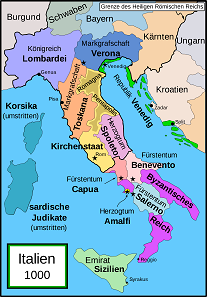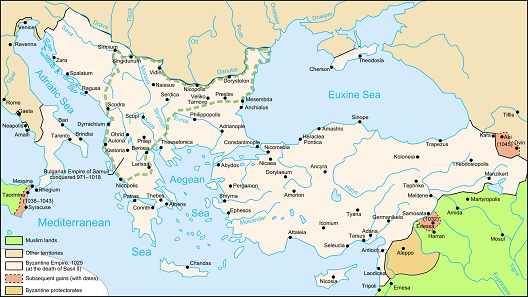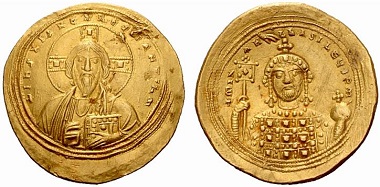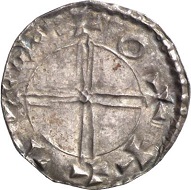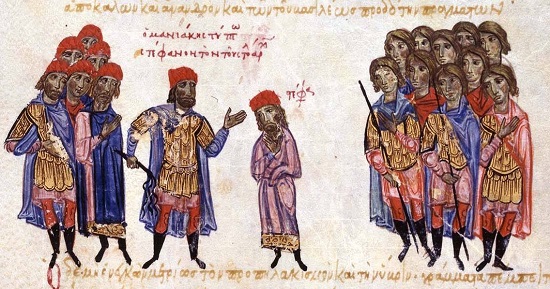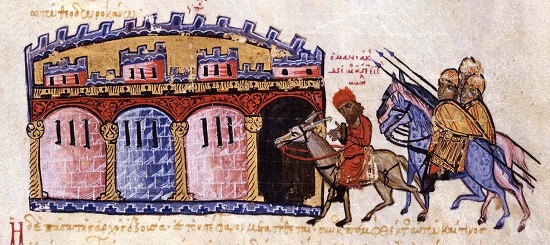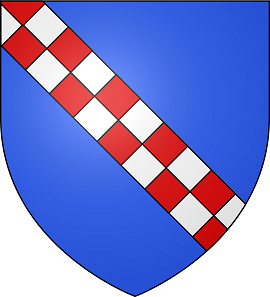translated by Almuth Klingner
The political situation around AD 1000
Around the year 1000, Sicily was firmly in Arab hands. Lower Italy was divided between the Byzantine Empire and the Lombards. Their territory was split up into many small, independently acting principalities.
The political situation in Italy around the year AD 1000. Source: Bamse / CC BY-SA 3.0
The Duchy of Amalfi was a small but powerful mercantile republic, similar to Venice. In the North, the torn-up country bordered with the Papal States. Such was the political situation when in the 1030s, the first Normans arrived in Sicily. They had crossed the sea, driven away by the political chaos in their own country and lured by the incredible stories of those who had seen the South for themselves.
A torn-up country and the dream of the South
For, at the latest since 1026 when Duke Richard II died, fratricidal war was raging in Normandy. At first, his sons fought about the inheritance. Unfortunately, both died: one during the dispute, the other while repenting for his violent crimes, on a pilgrimage to the Holy Land. In 1035, only a seven-year-old boy was left to reign over the ambitious lords – a boy who, by the way, would enter our history books as William the Conqueror.
When the first Normans set out to find a new home in the South, the great conqueror was a little lad, unable to keep his aristocrats from accumulating wealth at the expense of the weaker. Those who lost in the big struggle for possessions in Normandy set out to look for a new world, went East in order to find their fortune. And in the East, the most important employer for men experienced in battle was the Byzantine Empire.
The Byzantine Empire at its apex of power in the middle Byzantine era, at the time of Emperor Basil II’s death in 1025. Source: Nécropotame, Cplakidas / CC BY-SA 2.5
Fighting over Sicily
The Byzantine Emperor needed those warriors to protect his empire, which was being threatened by Arab opponents on all sides. Now and then, an emperor would even try to recapture a territory which previously had been lost. In the 1030s, a perfect chance came up to seize Sicily, which at the time had been under Arab rule for almost 200 years. The ruler of Palermo was in dispute with his brother. The latter secured support from the Fatimids in Cairo and was just about to oust his brother, when he in turn asked the Byzantine Emperor for help.
The Emperor, however, had to think about it first, and while he was still thinking, the brother in need of help had already been murdered. Now an intervention seemed even more attractive, as the estranged rebels appeared unable to counter a resolute attack.
Michael IV, the Paphlagonian, 1034-1041. Histamenon. From Auction NAC 33 (2006), 679.
At the time, the Emperor of Byzantium was Michael IV, who had gained power through a palace coup. He is said to have been intelligent, but he lacked education and suffered from epileptic seizures, which is why his brother John, who as a Eunuch had an important position at the palace, took on the actual governing tasks. He succeeded in reforming the military as well as the finances. In the course of this, among other things, the gold content of the histamena was lowered to 20 carats. This was only the beginning: His successors would use even poorer alloys for their gold coins, while keeping the weight at 24 keratia (approx. 4.40g).
In any case, Emperor Michael IV sent his best man, George Maniakes, a downright larger-than-life general. Contemporary historian Michael Psellos describes him as follows: “I saw the man myself and admired him, for nature had in this person united all necessary qualities of a military commander. He was three meters tall, so that in order to look at him, men had to tilt their head far back, as if they were raising their eye to the ridge of a steep hill chain or the summit of a high mountain. His appearance was neither noble nor pleasant, but brought to mind a violent storm. His voice sounded like thunder and his hands looked as if they were made to tear down walls or smash bronze doors. He had the jumping power of a lion; his frown was horrifying. Everything about him matched this impression. He who saw him for the first time had to discover that everything he had heard about him was an understatement.”
Harald Hardrada, 1045-1066. Denarius. ABH 5.12. From Künker Auction 121 (2007), 696.
The army led by this larger-than-life general was also impressive. The most powerful division was a Varangian Guard, i.e. a Viking unit, under the command of Harald Hardrada, who would later become king of Norway and lose the Battle of Stamford Bridge in 1066. The weakest link in the chain was a division of grumbling Lombards from Apulia, who had been forced into Byzantine service.
The Byzantines arrive in Sicily under the lead of George Maniakes and beat the Arabs. From a manuscript of the “Synopsis of Histories” by John Skylitzes (13th century). Skylitzes Matritensis (Biblioteca Nacional de Espana), fol. 212 r.
In late summer, the Byzantine army arrived in Sicily and slowly conquered the island’s East. Once more, George Maniakes proved his military abilities and annoyed the Byzantine aristocrats. For in his army served the Emperor’s young son-in-law, gaining his first military experience under the lead of the capable general Maniakes.
George Maniakes publicly reproaches Admiral Stephen. From a manuscript of the “Synopsis of Histories” by John Skylitzes (13th century). Skylitzes Matritensis (Biblioteca Nacional de Espana), fol. 213v top.
As is often the case, the young man had a far better opinion of himself than did his surroundings. And Maniakes was not discrete enough to point out the newcomer’s follies in a polite way.
George Maniakes is brought back to Constantinople as a prisoner. From a manuscript of the “Synopsis of Histories” by John Skylitzes (13th century). Skylitzes Matritensis (Biblioteca Nacional de Espana), fol. 213v bottom.
In any case, the offended youngster complained to his father-in-law, Emperor Michael IV, who immediately had General Maniakes brought to Constantinople and incarcerated. The military command was transferred to the Emperor’s son-in-law, with foreseeable consequences. The attack on Sicily failed, the army scattered.
Coat of Arms of the Hauteville family. Source: S@m / CC BY-SA 3.0
Three brothers from Hauteville
The majority of the soldiers returned to Apulia, where by now a revolt was underway. Namely the brutal recruitment for the expedition to Sicily had been the last straw that had broken the camel’s back: First, there were some smaller riots, then the Byzantine catepan was assassinated and the militia attacked the poorly-staffed garrisons. The soldiers returning from Sicily were supposed to bring things to order. They were fortified by recently recruited contingents from the capital, including three brothers from the Cotentin, William, Drogo and Humphrey, who, after their home, were called “of Hauteville”.
The fight for the Emperor was futile, which the three brothers were quick to realize. However, the chaos provided a perfect opportunity for personally gaining control over a part of this empire torn up by wars. After all, the Byzantine rule had been pushed back to only a few remaining exclaves, so why not secure some of the former Byzantine territory?
In the next episode, read how the three brothers fare, and how another protagonist enters the stage: Robert “the Cunning”.
Read all episodes of the series here.
And if you want to see more pictures of Sicily, we recommend our „Sicily in full bloom” series.




